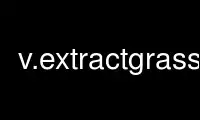
This is the command v.extractgrass that can be run in the OnWorks free hosting provider using one of our multiple free online workstations such as Ubuntu Online, Fedora Online, Windows online emulator or MAC OS online emulator
PROGRAM:
NAME
v.extract - Selects vector features from an existing vector map and creates a new vector
map containing only the selected features.
KEYWORDS
vector, extract, select, dissolve, random
SYNOPSIS
v.extract
v.extract --help
v.extract [-dtr] input=name [layer=string] [type=string[,string,...]] [cats=range]
[where=sql_query] output=name [file=name] [random=integer] [new=integer]
[--overwrite] [--help] [--verbose] [--quiet] [--ui]
Flags:
-d
Dissolve common boundaries (default is no)
-t
Do not copy attributes (see also ’new’ parameter)
-r
Reverse selection
--overwrite
Allow output files to overwrite existing files
--help
Print usage summary
--verbose
Verbose module output
--quiet
Quiet module output
--ui
Force launching GUI dialog
Parameters:
input=name [required]
Name of input vector map
Or data source for direct OGR access
layer=string
Layer number or name
Vector features can have category values in different layers. This number determines
which layer to use. When used with direct OGR access this is the layer name.
Default: 1
type=string[,string,...]
Types to be extracted
Input feature type
Options: point, line, boundary, centroid, area, face
Default: point,line,boundary,centroid,area,face
cats=range
Category values
Example: 1,3,7-9,13
where=sql_query
WHERE conditions of SQL statement without ’where’ keyword
Example: income < 1000 and inhab >= 10000
output=name [required]
Name for output vector map
file=name
Input text file with category numbers/number ranges to be extracted
If ’-’ given reads from standard input
random=integer
Number of random categories matching vector objects to extract
Number must be smaller than unique cat count in layer
new=integer
Desired new category value (enter -1 to keep original categories)
If new >= 0, attributes is not copied
Default: -1
DESCRIPTION
v.extract allows a user to select vector objects from an existing vector map and creates a
new map containing only the selected objects. Database tables can be queried with SQL
statements, if a connection is established. Dissolving (optional) is based on the output
categories. If 2 adjacent areas have the same output category, the boundary is removed.
If cats, file, random or where options are not specified, all features of given type and
layer are extracted. Categories are not changed in that case.
NOTES
Only features with a category number will be extracted. So if you want to extract
boundaries (which are usually without category, as that information is normally held in
the area’s centroid) you must first use v.category to add them.
EXAMPLES
The examples are intended for the North Carolina sample dataset:
Extract areas by category number with dissolving #1:
v.extract -d cats=1,2,3,4 input=soils_wake output=soil_groupa type=area new=0
produces a new vector soil_groupa, containing those areas from vector soils which have
category numbers 1 thru 4; any common boundaries are dissolved, and all areas in the new
map will be assigned category number 0.
Extract areas by category number with dissolving #2:
v.extract -d cats=1-4 input=soils_wake output=soil_groupa type=area new=-1
produces a new vector map soil_groupa containing the areas from vector soils which have
categories 1 thru 4. Any common boundaries are dissolved, all areas in the new map will
retain their original category numbers 1 thru 4, since new was set to -1.
Extract all areas and assign the same category to all:
v.extract input=soils_wake output=soil_groupa type=area new=1
produces a new vector map soil_groupa containing all areas from soils. No common
boundaries are dissolved, all areas of the new map will be assigned category number 1.
Extract vectors with SQL:
v.extract input=markveggy.shp output=markveggy.1 new=13 \
where="(VEGTYPE = ’Wi’) or (VEGTYPE = ’PS’) or (PRIME_TYPE=’Wi’)"
produces a new vector map with category number 13 if the SQL statement is fulfilled.
Extract vector features which have the given field empty:
v.extract input=lakes output=lakes_gaps where="FTYPE is NULL"
Extract vector features which have the given field not empty:
v.extract input=lakes output=lakes_ftype where="FTYPE not NULL"
Reverse extracting (behaves like selective vector objects deleting):
Remove meteorological stations from map which are located above 1000m:
# check what to delete:
v.db.select precip_30ynormals where="elev > 1000"
# perform reverse selection
v.extract -r input=precip_30ynormals output=precip_30ynormals_lowland \
where="elev > 1000"
# verify
v.db.select precip_30ynormals_lowland
Dissolving based on column attributes:
# check column names:
v.info -c zipcodes_wake
# reclass based on desired column:
v.reclass input=zipcodes_wake output=zipcodes_wake_recl_nam column=ZIPNAME
# verify:
v.info -c zipcodes_wake_recl_nam
v.db.select zipcodes_wake_recl_nam
# dissolve:
v.extract -d input=zipcodes_wake_recl_nam output=zipcodes_wake_regions
This produces a new vector map with common boundaries dissolved where the reclassed
attributes of adjacent (left/right) areas are identical.
Remove islands from polygon map
v.extract input=map_with_islands output=maps_without_islands cats=1-99999
# and/or
v.extract -d in=map_with_islands out=maps_without_islands
Extract 3 random areas from geology map
v.extract input=geology output=random_geology type=area random=3
This creates a new map with three random categories matching areas. Note that there may
be more than one feature with the same category.
Use v.extractgrass online using onworks.net services
